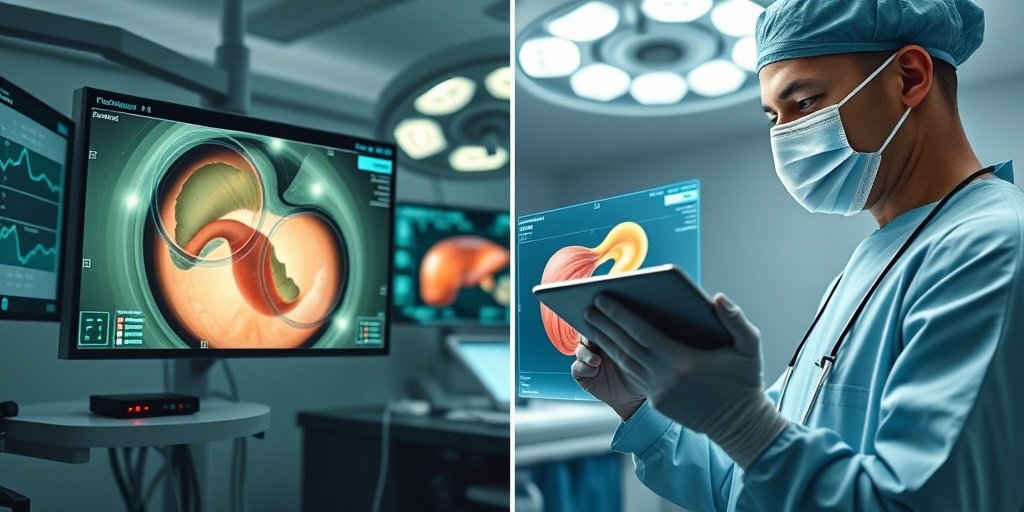⚡ Quick Summary
This study explores the use of Artificial Intelligence (AI) to analyze 481 laparoscopic cholecystectomy videos, aiming to identify clinical factors that influence the recognition of critical anatomical structures. The findings reveal that surgeon experience and case complexity significantly impact the visualization of anatomy during surgery.
🔍 Key Details
- 📊 Dataset: 481 laparoscopic cholecystectomy videos from Christchurch Hospital, New Zealand
- 🧩 Features used: Time points of cystic duct and cystic artery visibility, operative phases
- ⚙️ Technology: AI algorithms for video analysis
- 🏆 Metrics: Nine timing metrics derived from AI outputs
🔑 Key Takeaways
- 🤖 AI analysis can automate the review of surgical videos, reducing manual workload.
- 📈 Operative time increases with the complexity of the case.
- 👨⚕️ Consultants showed a higher proportional duration of anatomy visualization compared to trainees.
- 🔍 Cystic duct identification typically precedes that of the cystic artery, regardless of complexity.
- 💡 AI-derived analytics correlate with clinical factors, demonstrating practical utility in surgical settings.
- 🌟 Potential benefits for patient outcomes through enhanced surgical training and decision-making.
- 📅 Study duration: Conducted over three years.

📚 Background
The achievement of a critical view of safety in laparoscopic surgeries is essential for minimizing complications. However, traditional methods of analyzing surgical videos are often hindered by the inefficiency of manual work. The integration of AI into this process presents an opportunity to enhance the scale and efficiency of clinical studies, potentially leading to improved surgical outcomes.
🗒️ Study
This research was conducted at Christchurch Hospital over three years, where 481 laparoscopic cholecystectomy videos were recorded. AI algorithms were employed to analyze these videos, marking critical time points for the visibility of the cystic duct and cystic artery, as well as different operative phases. The study aimed to correlate these AI-derived metrics with surgeon experience and case complexity.
📈 Results
The analysis revealed that as the complexity of the surgical case increased, so did the operative time. Notably, consultants demonstrated a significantly higher proportional duration of anatomy visualization compared to trainees, particularly in complex cases. Furthermore, the cystic duct was frequently identified before the cystic artery, irrespective of the complexity grade, highlighting a consistent pattern in anatomical recognition.
🌍 Impact and Implications
The findings of this study underscore the transformative potential of AI in surgical video analysis. By automating the review process, we can gain valuable insights that may enhance surgical training and improve patient safety. The ability to correlate AI analytics with clinical factors could lead to more informed decision-making in the operating room, ultimately benefiting patient outcomes and surgical education.
🔮 Conclusion
This study illustrates the real-world utility of AI in surgical settings, particularly in the analysis of laparoscopic procedures. By leveraging AI technology, we can streamline the review of surgical videos, providing critical insights that enhance both training and patient care. The future of surgical education and practice looks promising with the continued integration of AI and machine learning.
💬 Your comments
What are your thoughts on the integration of AI in surgical video analysis? We would love to hear your insights! 💬 Share your comments below or connect with us on social media:
Towards determining clinical factors influencing critical structure identification using Artificial Intelligence.
Abstract
BACKGROUND: Studys into factors influencing critical view of safety achievement depends on large volumes of video data and granular anatomical annotations, which are limited by the burden of inefficient manual work. Artificial intelligence (AI) has the potential to radically scale the size of clinical studies by automating operative video analysis.
METHODS: 481 videos of laparoscopic cholecystectomy were recorded at Christchurch Hospital, New Zealand over three years. AI algorithms analysed the videos, marking time points where the cystic duct and cystic artery were visible and operative phases. Metrics were stratified by surgeon experience (trainee or consultant) and case complexity (North Shore Grading scale). Nine timing metrics were derived based on the outputs of the AI algorithms and compared against the clinical variables.
RESULTS: Operative time increased with increasing operative difficulty. Significantly consultants demonstrated a higher proportional duration of anatomy visualisation than trainees in complex patients The cystic duct was commonly identified prior to the cystic artery independent of complexity grade.
CONCLUSION: Surgical video review offers the potential of significant new insights with substantive benefits to patients but is often limited by the costly effort of manual analysis. This paper correlates AI-derived analytics with clinical factors demonstrating real-world utility of AI video analysis.
Author: [‘Tranter-Entwistle I’, ‘Culshaw L’, ‘Vichhi R’, ‘Luke Y’, ‘Addis C’, ‘Luengo I’, ‘Grammatikopoulou M’, ‘Kerr K’, ‘Stoyanov D’, ‘Eglinton T’, ‘Connor S’]
Journal: HPB (Oxford)
Citation: Tranter-Entwistle I, et al. Towards determining clinical factors influencing critical structure identification using Artificial Intelligence. Towards determining clinical factors influencing critical structure identification using Artificial Intelligence. 2025; (unknown volume):(unknown pages). doi: 10.1016/j.hpb.2025.03.452